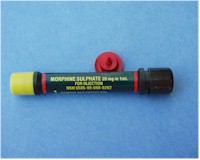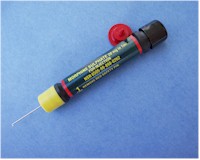|

Morphine Injector

Remove the Red Safety Plug

Hold the yellow end against
the thigh. Depress the black
plunger to fire the injector.
|
Morphine injectors come in a variety of sizes
and shapes.
Shown here are auto injectors containing 20 mg of morphine sulfate in 1
ml of water.
Morphine is a narcotic used to relieve severe pain. It blocks much of
the pain but also has a calming effect. It should not be used for minor
pain.
While morphine is a powerful pain reliever, it can depress
respirations. This isn't a problem for those in severe pain, as the pain
itself blocks the respiratory depression effect of the morphine. For those
in lesser amounts of pain, respiratory rate should be monitored
periodically.
To operate (video):
- If possible, cleanse the skin of the injection site (upper outside
thigh, upper outer quadrant of the buttock) with alcohol. If alcohol
is not available, use any available cleaning agent (water is
ok).
- Remove the red safety plug from the injector.
- Place the yellow end of the injector against the skin of the
injection site.
- Depress the black firing plunger.
- This action causes a release of gas within the injector that drives
the hypodermic needle through the yellow protective cap and about an
inch into the muscle. It also pushes 1 ml of fluid, containing 20 mg
of morphine, through the needle and into the muscle tissue.
Make a note on the field medical triage card (DD 1380) of the time the
injection was given.
Victims treated with morphine will usually demonstrate
"pin-point" pupils.
It can be repeated every 4 hours as needed for control of pain. Repeat
dosing should be done only with great caution (if at all) if the
respiratory rate is less than 10 breaths per minute).
Additional information on Morphine
Weight: 0.02 pounds
Approved for public release; Distribution is unlimited.
The listing of any non-Federal product in this CD is
not an endorsement of the product itself, but simply an acknowledgement of the
source.
Operational Medicine 2001
Health Care in Military Settings
Home ·
Military Medicine
·
Sick Call ·
Basic Exams ·
Medical Procedures
·
Lab and X-ray ·
The Pharmacy ·
The Library ·
Equipment ·
Patient Transport
·
Medical Force
Protection ·
Operational Safety ·
Operational
Settings ·
Special Operations
·
Humanitarian
Missions ·
Instructions/Orders ·
Other Agencies ·
Video Gallery ·
Phone Consultation ·
Forms ·
Web Links ·
Acknowledgements ·
Help ·
Feedback
|
Bureau of
Medicine and Surgery
Department of the Navy
2300 E Street NW
Washington, D.C
20372-5300 |
Operational
Medicine
Health Care in Military Settings
CAPT Michael John Hughey, MC, USNR
NAVMED P-5139
January 1, 2001 |
United States Special Operations Command
7701 Tampa Point Blvd.
MacDill AFB, Florida
33621-5323 |
*This web version is provided by
The Brookside Associates Medical Education
Division. It contains original contents from the official US Navy
NAVMED P-5139, but has been reformatted for web access and includes advertising
and links that were not present in the original version. This web version has
not been approved by the Department of the Navy or the Department of Defense.
The presence of any advertising on these pages does not constitute an
endorsement of that product or service by either the US Department of Defense or
the Brookside Associates. The Brookside Associates is a private organization,
not affiliated with the United States Department of Defense.
Contact Us · · Other
Brookside Products
|